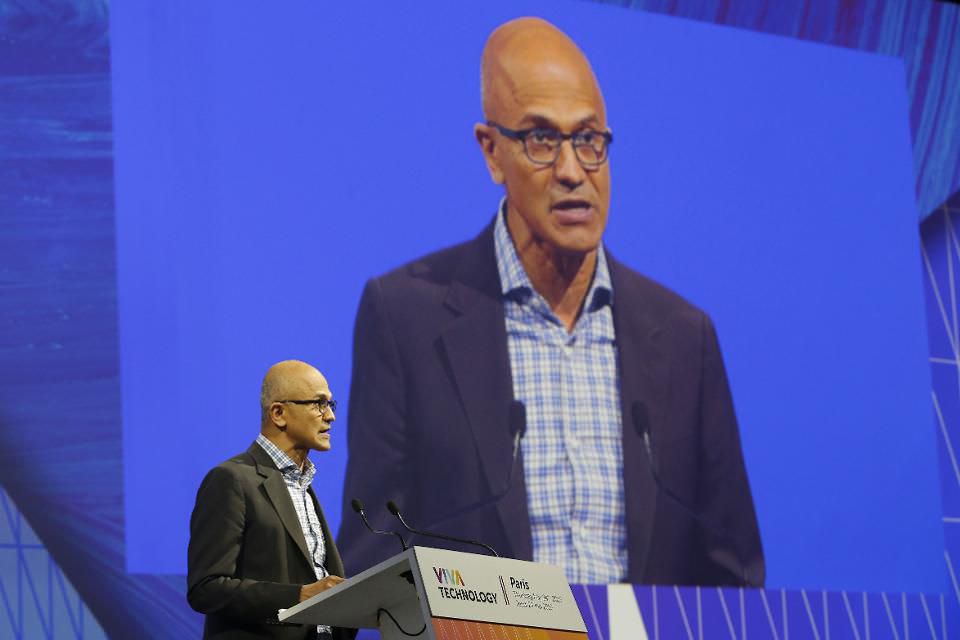Quick quiz—name the company whose “top news stories of 2013” included the following: shut down the Zune Marketplace; bought Nokia’s smartphone business for about $7 billion; quickly followed the disastrous release of a new operating system (8) with an upgrade/replacement (8.1); introduced two new tablets; lost trademark battle for the name “SkyDrive.”
It seems utterly unimaginable that only four years ago, an annual list of Microsoft’s biggest news stories could include such a mix of trifles, blunders and disasters.
But on Feb. 3, 2014, all that confusion and lack of direction changed profoundly when Satya Nadella was named the third CEO in Microsoft’s storied history.
How profoundly?
- On Jan. 7, 2014, in the waning days of Steve Ballmer’s wind-down and four weeks before Nadella was named as CEO, Microsoft’s market cap was $302.2 billion.
- On Jan. 8, 2018, after 47 months of Nadella’s leadership, Microsoft’s market cap stood at $681.6 billion.
- Microsoft has a very good chance to become the first vendor to reach $20 billion in annual enterprise-cloud revenue, and it might do so by the end of this calendar year. (Microsoft reached a $20-billion annualized run rate last year, but I’m referring to it actually reaching $20 billion in real revenue for the trailing 12 months, not a projection for what could happen over a forward-looking period of time. Both sets of numbers are legitimate, but they refer to two very different metrics.)
- Microsoft has been, for most of 2017, the top-rated of all enterprise-cloud vendors, fending off savage competition from Amazon, IBM, Salesforce.com and others.

And without question, the person most responsible for that extraordinary turnaround, transformation, rejuvenation, re-imagining, overhaul, restoration, resurrection, and near-miracle reversal is the eloquent and passionate Nadella, who, as if he didn’t have enough going on in 2017, somehow managed to write a book on business and leadership called Hit Refresh.
Throughout most of 2017, as I consistently put Microsoft at the top of my rankings of cloud vendors, I’d get questions along the lines of, “So dude, ever hear of, like, AMAzon? They’re, like, bigger than every other cloud vendor combined— multiplied times a hundred!”
As it turns out, I have indeed heard of Amazon, and have rightfully been highly complimentary toward the cloud achievements of Andy Jassy and his powerful team.
But as I said in an October article called Why Amazon Won’t Catch #1 Microsoft In The Cloud—Because It’s All About Software, in spite of all of Amazon’s IaaS prowess and its innovative technology and customer-engagement models, the next phase of the cloud evolution will be centered very deeply on enterprise software—and there is simply no way that Amazon can match Microsoft on that competitive dynamic.
In that piece, I wrote, “So fast-forwarding back to today, as Artificial Intelligence is arguably the hottest and highest-potential new technology in the enterprise space, only a software-native company like Microsoft could even dream about the ability to launch an AI division with more than 5,000 computer scientists and software engineers. Not 50 great people or 500, but more than 5,000. Microsoft created that AI unit just over a year ago.”
Satya Nadella created that AI powerhouse by bringing together an array of different teams from across the company to give them a common purpose, a sense of shared challenge and destiny, and to underscore to his company and to the world that Microsoft was going all-in on AI and is fully determined to be the category king in that world-changing space.
And in his uniquely eloquent style, here’s how Nadella described the significance—to Microsoft and for its customers—of the formation of that big and powerful AI team: “The core currency of any business going forward will be the ability to convert their data into AI that drives competitive advantage.”
That decision to unify fragmented teams is another part of Nadella’s triumphant reinvigoration of Microsoft—whereas in the past the company was often hamstrung or hobbled by its size and unwieldy momentum, Nadella has transformed the structure and culture and attitude of the company such that its mass is now a formidable asset.
Look at how that vision is expressed by Nadella in this excerpt from an article I wrote several months ago called 10 Powerful Examples Of Microsoft CEO Satya Nadella’s Transformative Vision:
“Overall the approach we have taken for multiple years now is to transform everything that we do inside the company, whether it’s about creation, how we are organized in the R&D, how we think about breaking down any silos and category definitions we may have had in the past, how we think about even marketing and the marketing approach and then, of course, even with the go to market. And this transformation is ongoing. This has been happening over multiple years, but we now have got very good customer momentum, because ultimately this is all driven by the opportunity at hand, which is much bigger than anything that we have participated in the past, so the total addressable market is much bigger. And second, our customer expectations and our partner expectations of how we show up with them has changed. And so over the years we have been making changes and now that we have a lot more momentum and critical mass we’re going to that next phase and that’s what you are seeing us in terms of changing the skill sets, changing the scope of how we show up to support the digital transformation needs of both large customers, as well as small businesses.”
And here’s a tangible example of how Nadella and Microsoft delivered on that promise (also from that same article):
“The workplace is transforming — from changing employee expectations, a need for more diverse skills and globally distributed teams, and an increasingly complex threat environment. Only Microsoft gives customers a comprehensive approach for this new culture of work. Earlier this month we introduced Microsoft 365, which brings together Office 365, Windows 10 and Enterprise Mobility & Security in a complete, secure solution to empower employees, safeguard businesses and simplify IT management. Microsoft 365 is a fundamental shift in how we design, build and go-to-market to address customer needs. Fortune 500 customers Fed-Ex, Dow Chemical, Staples and Progressive Insurance all chose Microsoft 365. The success of our Secure Productive Enterprise offering with its triple-digit seat growth is one reason we are investing in Microsoft 365 for businesses of all sizes.”
Other CEOs in the Cloud Wars also delivered exceptional performance in 2017:
- Ginni Rometty’s ongoing transformation of IBM into a cloud-plus-cognitive software company continues to be extremely impressive. Along the way, IBM and Rometty have created an entirely new and customer-centric cloud segment that drives the cloud-purist police crazy: helping huge corporate customers convert their legacy IT systems into cloud or cloud-compatible environments, which has turned into an $8-billion business for IBM.
- Andy Jassy is maneuvering Amazon into more of a PaaS player and has solidified Amazon’s pre-eminence as the IaaS provider of choice for several of the world’s top SaaS providers—while continuing to drive 40% growth for AWS, whose trailing 12-month cloud revenue is now just over $16 billion.
- Marc Benioff has propelled Salesforce.com to $10 billion in enterprise-cloud software revenue and has predicted Salesforce could well be the first to reach $20 billion. He’s also generated huge value for the entire cloud industry by continuing to be probably the most vocal and widely recognized evangelist in the world for the enterprise cloud.
But as good as those 3 have been, Nadella’s simply made more of an impact, driven more customer-centric innovation, and articulated a vision for how not only the cloud but some other transformative new technologies—AI, Machine Learning, Blockchain, IoT—will continue to create fabulous new business value and opportunities for companies across all industries for many years to come.
In attempting to capture the essence of Nadella’s achievements in 2017, let me offer these two paragraphs that I wrote about him in the piece cited above showcasing 10 examples of his powerful vision:
“In doing so, Satya Nadella has made Microsoft into that most formidable of competitors: while it can surely float like a butterfly, it can also develop products faster than ever before, put more resources in front of partners and customers, plow more investments into promising technologies, share more world-class ideas, and tie its customers vast and disparate “digital estates” together seamlessly in ways no other enterprise-tech company can come close to matching.
“And Nadella does so in a style that is visionary, emboldening, insightful, and eloquent—he’s a leader who fearlessly tells his troops that the way forward will be brimming with change and disruption and challenges, while also inspiring them to be not just willing but in fact eager to make that journey with him.”
*******************
RECOMMENDED READING FROM CLOUD WARS:
The World’s Top 5 Cloud-Computing Suppliers: #1 Microsoft, #2 Amazon, #3 Salesforce, #4 SAP, #5 IBM
Amazon Versus Oracle: The Battle for Cloud Database Leadership
As Amazon Battles with Retailers, Microsoft Leads Them into the Cloud
Why Microsoft Is #1 in the Cloud: 10 Key Insights
SAP’s Stunning Transformation: Qualtrics Already “Crown Jewel of Company”
Watch Out, Microsoft and Amazon: Google Cloud CEO Thomas Kurian Plans To Be #1
The Coming Hybrid Wave: Where Do Microsoft, IBM and Amazon Stand? (Part 1 of 2)
Oracle, SAP and Workday Driving Red-Hot Cloud ERP Growth Into 2019
*********************








